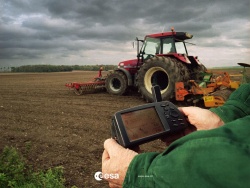If you wish to contribute or participate in the discussions about articles you are invited to contact the Editor
Galileo High Accuracy Service (HAS): Difference between revisions
mNo edit summary |
Gema.Cueto (talk | contribs) No edit summary |
||
| Line 5: | Line 5: | ||
|YearOfPublication=2011 | |YearOfPublication=2011 | ||
|Logo=GMV | |Logo=GMV | ||
|Title= | |Title=Galileo High Accuracy Service (HAS) | ||
}} | }} | ||
The [[GALILEO General Introduction|GALILEO]] System will be an independent, global, European-controlled, satellite-based navigation system and will provide a number of guaranteed services to users equipped with Galileo-compatible receivers. | The [[GALILEO General Introduction|GALILEO]] System will be an independent, global, European-controlled, satellite-based navigation system and will provide a number of guaranteed services to users equipped with Galileo-compatible receivers. | ||
Revision as of 09:29, 8 March 2019
| GALILEO | |
|---|---|
| Title | Galileo High Accuracy Service (HAS) |
| Edited by | GMV |
| Level | Basic |
| Year of Publication | 2011 |
The GALILEO System will be an independent, global, European-controlled, satellite-based navigation system and will provide a number of guaranteed services to users equipped with Galileo-compatible receivers.
Encrypted and accurate to the nearest centimetre, the GALILEO Commercial Service (CS) allows for development of applications for professional or commercial use owing to improved performance and data with greater added value than that obtained through the open service.[1]
Purpose
The Commercial Service (CS) is aimed at market applications requiring higher performance than offered by the Open Service. It provides added value services on payment of a fee. Galileo CS uses combination of two encrypted signals for higher data throughput rate and higher accuracy authenticated data.
The foreseen applications will be based on: [2]
- Dissemination of data with a rate of 500 bps, for added value services;
- Broadcasting of two signals, separated in frequency from the Open Services signals in differential applications to facilitate advanced applications such as integration of Galileo positioning applications with wireless communications networks, high accuracy positioning and indoor navigation.
These will be developed by service providers, which will buy the right to use the two commercial signals from the Galileo operator.
Developing commercial applications either by using the commercial signals alone, or by combining them with other Galileo signals or external communications systems, opens a wide range of possibilities. The worldwide coverage brings a strong advantage for applications requiring global data broadcast. The Commercial Service does not offer integrity information.[3]
Performance and features
The Galileo Commercial Service is based on adding two signals to the Open access signals. This pair of signals is protected through commercial encryption, which is managed by the service providers and the future Galileo operator. Access is controlled at the receiver level, using access-protection keys.
The Galileo Operating Company (GOC) will determine the level of performance it can offer for each commercial service together with ascertaining the demands of Industry and the needs of the consumer. It is intended to provide a guarantee for this service. The Commercial Service will be a controlled access service operated by Commercial Service Providers acting after a license agreement between them and the GOC. Commercial service providers will make decisions on the offered services: e.g. integrity data, differential corrections for local areas, etc… which will depend on the final characteristics of the other services offered by Galileo. [2]
Implementation and Applications
The Galileo Commercial Service (CS) signals will be the Open Services Signals, plus two encrypted signals (ranging codes and data), on the “E6” band. Typical value-added services could include service guarantees, precise timing services, the provision of ionosphere delay models, local differential correction signals for extreme-precision position determination and other services based on the broadcast of system information data.
The European Commission launched the AALECS (Authentication and Accurate Location Experimentation with the Commercial Service) project in January 2014 aiming for the demonstration of the real performance of future high accuracy and authentication services of Galileo. The outcome of the project, awarded to a consortium led by GMV including CGI, Qascom, IFEN, Veripos and KU Leuven, will be a platform able to connect to the European GNSS Service Centre (GSC) and transmit real time CS data through the Galileo satellites. On 17 June, 2014, the transmission by the available IOV Galileo satellites of data external to the Galileo system was successfully demonstrated. The broadcasted data were generated offline before transmission, but future architectures under analysis may allow continuous real-time transmission with a latency of some seconds.[4]On July, 2014 it was made a 10 day tests campaign that showing the successful tracking and data demodulation of the encrypted signals from the four available Galileo satellites. The tests were performed during periods wherein all satellites transmitting E6 encrypted signals were tracked simultaneously. The tests verified the Galileo Commercial Service (CS) signal’s encryption functionalities, with the data received containing authentication and high accuracy information previously generated outside the Galileo system. This is an essential feature to ensuring Galileo’s high accuracy and authentication services.[5]
References
- ^ Mid-term review of the European satellite radio navigation programmes
- ^ a b Galileo Mission High Level Definition, v3, September 2002.
- ^ ESA Galileo web page
- ^ First Signal-In-Space tests of the Galileo Commercial Service Demonstrator, EGNOS Portal, GSA, 30 June, 2014
- ^ First Galileo Commercial Service Demonstration with Encrypted Signals, EGNOS Portal, GSA, July, 30, 2014


